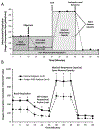Preliminary observations of mitochondrial dysfunction in Prader-Willi syndrome
- PMID: 30289596
- PMCID: PMC6312481
- DOI: 10.1002/ajmg.a.40526
Preliminary observations of mitochondrial dysfunction in Prader-Willi syndrome
Abstract
Prader-Willi syndrome (PWS) is a complex multisystem disorder because of errors in genomic imprinting with severe hypotonia, decreased muscle mass, poor suckling, feeding problems and failure to thrive during infancy, growth and other hormone deficiency, childhood-onset hyperphagia, and subsequent obesity. Decreased energy expenditure in PWS is thought to contribute to reduced muscle mass and physical activity but may also relate to cellular metabolism and disturbances in mitochondrial function. We established fibroblast cell lines from six children and adults with PWS and six healthy controls for mitochondrial assays. We used Agilent Seahorse XF extracellular flux technology to determine real-time measurements of several metabolic parameters including cellular substrate utilization, Adenosine Triphosphate (ATP)-linked respiration, and mitochondrial capacity in living cells. Decreased mitochondrial function was observed in the PWS patients compared to the healthy controls with significant differences in basal respiration, maximal respiratory capacity, and ATP-linked respiration. These results suggest disturbed mitochondrial bioenergetics in PWS although the low number of studied subjects will require a larger subject population before a general consensus can be reached to identify if mitochondrial dysfunction is a contributing factor in PWS.
Keywords: Prader-Willi syndrome; fibroblasts; healthy controls; mitochondrial assays and dysfunction.
© 2018 Wiley Periodicals, Inc.
Conflict of interest statement
There are no conflicts of interest to report for any of the authors.
Figures




Similar articles
-
The changing purpose of Prader-Willi syndrome clinical diagnostic criteria and proposed revised criteria.Pediatrics. 2001 Nov;108(5):E92. doi: 10.1542/peds.108.5.e92. Pediatrics. 2001. PMID: 11694676
-
The behavioral impact of growth hormone treatment for children and adolescents with Prader-Willi syndrome: a 2-year, controlled study.Pediatrics. 2002 Feb;109(2):E35. doi: 10.1542/peds.109.2.e35. Pediatrics. 2002. PMID: 11826245 Clinical Trial.
-
Impact of genetic subtypes of Prader-Willi syndrome with growth hormone therapy on intelligence and body mass index.Am J Med Genet A. 2019 Sep;179(9):1826-1835. doi: 10.1002/ajmg.a.61293. Epub 2019 Jul 16. Am J Med Genet A. 2019. PMID: 31313492 Free PMC article.
-
[Clinical aspects and genetics of Prader-Willi syndrome].Klin Padiatr. 2001 May-Jun;213(3):91-8. doi: 10.1055/s-2001-15857. Klin Padiatr. 2001. PMID: 11417368 Review. German.
-
Prader-Willi syndrome: a review of clinical, genetic, and endocrine findings.J Endocrinol Invest. 2015 Dec;38(12):1249-63. doi: 10.1007/s40618-015-0312-9. Epub 2015 Jun 11. J Endocrinol Invest. 2015. PMID: 26062517 Free PMC article. Review.
Cited by
-
Molecular Changes in Prader-Willi Syndrome Neurons Reveals Clues About Increased Autism Susceptibility.Front Mol Neurosci. 2021 Oct 29;14:747855. doi: 10.3389/fnmol.2021.747855. eCollection 2021. Front Mol Neurosci. 2021. PMID: 34776864 Free PMC article.
-
Urine lactate concentration as a non-invasive screener for metabolic abnormalities: Findings in children with autism spectrum disorder and regression.PLoS One. 2022 Sep 9;17(9):e0274310. doi: 10.1371/journal.pone.0274310. eCollection 2022. PLoS One. 2022. PMID: 36084111 Free PMC article.
-
The Neural Progenitor Cell-Associated Transcription Factor FoxG1 Regulates Cardiac Epicardial Cell Proliferation.Stem Cells Int. 2024 Jan 11;2024:8601360. doi: 10.1155/2024/8601360. eCollection 2024. Stem Cells Int. 2024. PMID: 38239823 Free PMC article.
-
Prader-Willi syndrome: an update on obesity and endocrine problems.Ann Pediatr Endocrinol Metab. 2021 Dec;26(4):227-236. doi: 10.6065/apem.2142164.082. Epub 2021 Dec 31. Ann Pediatr Endocrinol Metab. 2021. PMID: 34991300 Free PMC article.
-
Prolapsed Rectum and Risk Factors in Prader-Willi Syndrome: A Case-Based Review.J Pediatr Genet. 2021 Mar 3;11(1):1-4. doi: 10.1055/s-0041-1724049. eCollection 2022 Mar. J Pediatr Genet. 2021. PMID: 35186383 Free PMC article.
References
-
- Ainscow EK, & Brand MD (1995). Top‐down control analysis of systems with more than one common intermediate. European Journal of Biochemistry, 231(3), 579–586. - PubMed
Publication types
MeSH terms
Substances
Grants and funding
LinkOut - more resources
Full Text Sources
Medical

